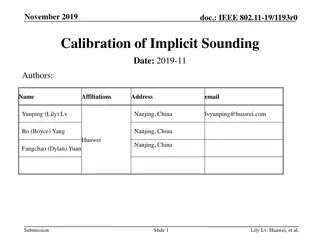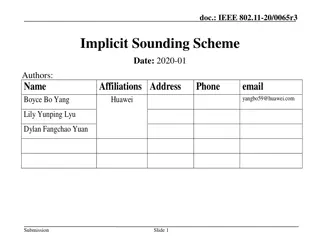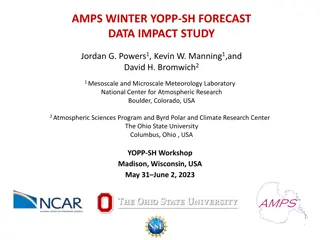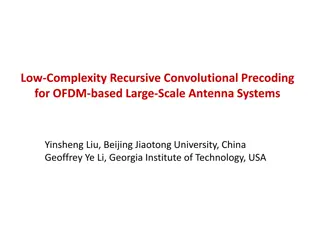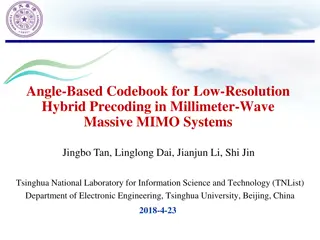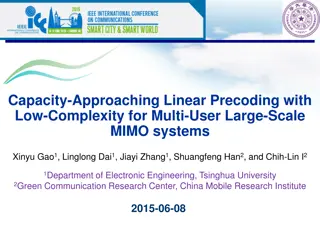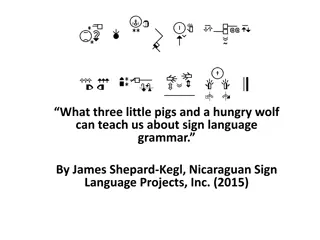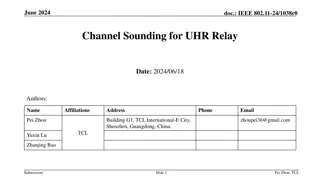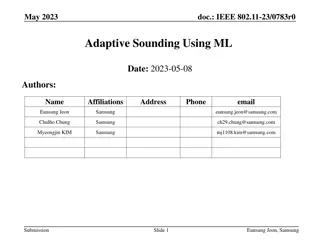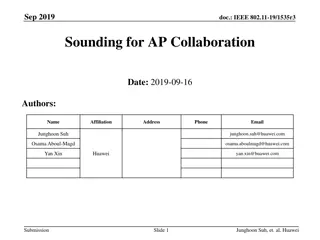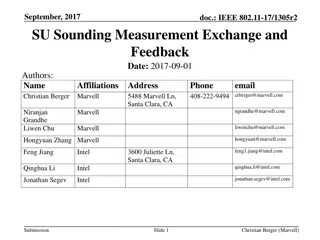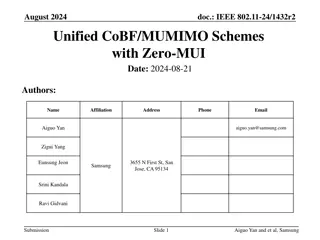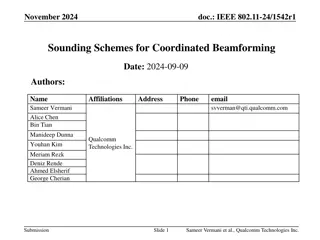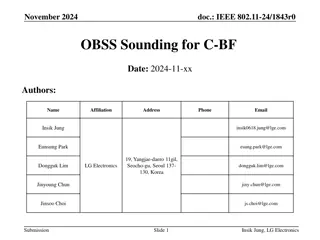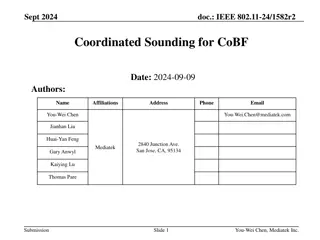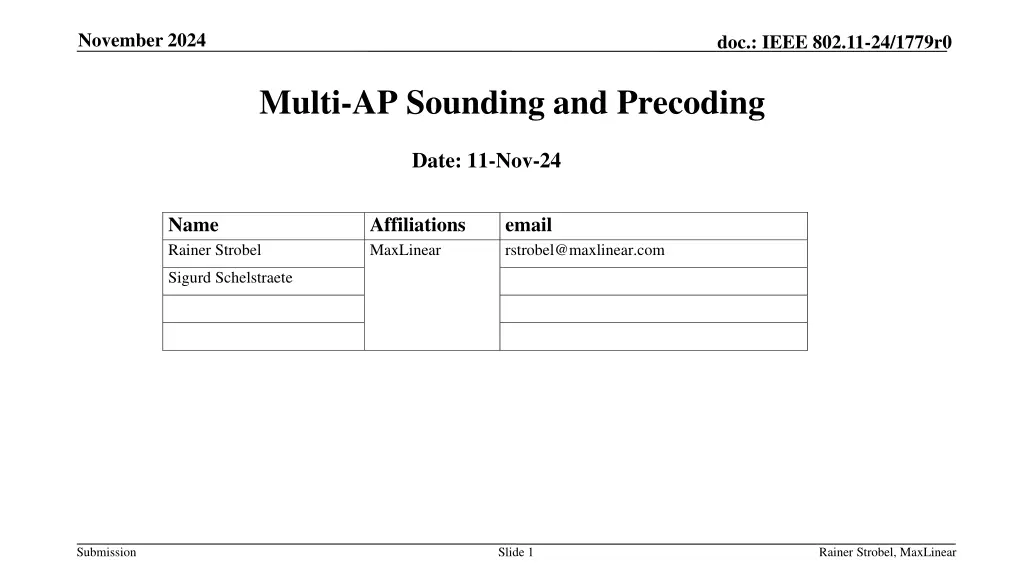
IEEE 802.11-24 Multi-AP Sounding and Precoding
Explore the November 2024 document on IEEE 802.11-24/1779r0, presenting insights into multi-AP sounding, precoding, spatial nulling math, joint and independent sounding methods, and more for wireless communication advancements.
Download Presentation

Please find below an Image/Link to download the presentation.
The content on the website is provided AS IS for your information and personal use only. It may not be sold, licensed, or shared on other websites without obtaining consent from the author. If you encounter any issues during the download, it is possible that the publisher has removed the file from their server.
You are allowed to download the files provided on this website for personal or commercial use, subject to the condition that they are used lawfully. All files are the property of their respective owners.
The content on the website is provided AS IS for your information and personal use only. It may not be sold, licensed, or shared on other websites without obtaining consent from the author.
E N D
Presentation Transcript
November 2024 doc.: IEEE 802.11-24/1779r0 Multi-AP Sounding and Precoding Date: 11-Nov-24 Name Rainer Strobel Affiliations MaxLinear email rstrobel@maxlinear.com Sigurd Schelstraete Submission Slide 1 Rainer Strobel, MaxLinear
November 2024 doc.: IEEE 802.11-24/1779r0 Introduction Previous contributions on coordinated beamforming and spatial nulling Coordinated spatial re-use and spatial nulling is accepted for TGbn [8] In [6, 7] the high-level concept and a performance evaluation is presented Proposals for the sounding procedure were recently presented in [1, 2] This contribution Joint sounding vs. independent sounding Sounding information exchange between APs Joint optimization of spatial nulling Submission Slide 2 Rainer Strobel, MaxLinear
November 2024 doc.: IEEE 802.11-24/1779r0 Spatial Nulling Math Spatial nulling math example (S=2 APs, M=4 STAs) Receiver equalizer (4 STAs) Channel Transmitter precoding (2 APs) ?1 ? ? ?2 ?11 ?21 ?31 ?41 ?12 ?22 ?32 ?42 ? ? ?4 ?1 ? ? ?2 P= G= ? = ?3 ? ? STA with 2 antennas and 1 spatial stream: ??= ??1 AP-STA association: e.g., STA m=1, 2 with AP s=1 and STA m=3,4 with AP s=2 Spatial nulling conditions: ?3 ? ?4 ?41 ??2 , 1x2 matrix ? ?31 ?1= ?, ?1 ? ?2 ?12 ?22 ?2= ? ? Submission Slide 3 Rainer Strobel, MaxLinear
November 2024 doc.: IEEE 802.11-24/1779r0 Sounding Math (Joint Sounding) SVD-based feedback (Joint Sounding): H ??= ??1 ?? ??2 = ?????? H??= ?? ????= ?? 1?? H H His implicitly assumed. . From the feedback of all STAs, the 1?? With V matrix feedback, the receive equalizer ??= ?? The feedback of STA m is ?? nulling conditions are ?31 ?41 H= ??1 H ?1= ?, ?12 H H ??2 H ?2= ? H H ?22 Nomenclature: ?STA index,? AP index ? Submission Slide 4 Rainer Strobel, MaxLinear
November 2024 doc.: IEEE 802.11-24/1779r0 Sounding Math (Independent sounding) SVD-based feedback for Data: H ???= ????????? ??? ??????= ??? 1??? H???= ??? H H The nulling feedback for the un-associated AP must be done with the same assumption on the receive equalizer, e.g., ???= ??? For AP ? ? the feedback is ??????. 1??? H. Nomenclature: ?STA index,? AP index ? Submission Slide 5 Rainer Strobel, MaxLinear
November 2024 doc.: IEEE 802.11-24/1779r0 Sounding Joint Sounding proposal from [1, 2] AP1 and STAs m=3, 4 associated with AP2, the feedback give to AP1 (?11,?12 from STA1 and ?21,?22 from STA2) and AP2 (?31,?32 from STA3 and ?41?42 from STA4 ) is as follows: ?1?11 ?2?21 ?2?22 ?3?31 ?4?41 ?4?42 ?4?4 APs get more information than needed from associated STAs. Some of the information from un- associated STAs is needed. Information requried by AP1 and AP2 to compute the nulling: ?1?11 ?2?21 ?3?31 ?4?41 To provide appropriate feedback, AP1 needs ?3?31 ?1?12 ?1?1 ?2?2 ?3?3 ?1?12 ?2?22 ?3?32 ?4?42 = ? = ? = . ?3?32 ?4?41 from AP2 and AP2 needs ?1?12 ?2?22 from AP1. Submission Slide 6 Rainer Strobel, MaxLinear
November 2024 doc.: IEEE 802.11-24/1779r0 AP-AP Communication How to do the exchange: Option 1 [1,2]: STAs send feedback in a way that all APs can receive it. requires very conservative transmission settings for large amount of data (inefficient). For spatial nulling a lower resolution of the feedback may be acceptable Option 2: Dedicated feedback exchange Submission Slide 7 Rainer Strobel, MaxLinear
November 2024 doc.: IEEE 802.11-24/1779r0 Joint Optimization Feedback exchange phase allows to jointly optimize precoding Use the best possible equalizer rather than ?? or ??? Top figure indepenent nulling Bottom figure is joint optimization of nulling (40% higher rates avg.) STAs associated with AP1 STAs associated with AP2 Hfrom joint sounding Hfrom independent sounding AP1 AP2 STAs associated with AP1 STAs associated with AP2 AP1 AP2 Submission Slide 8 Rainer Strobel, MaxLinear
November 2024 doc.: IEEE 802.11-24/1779r0 Independent Sounding Independent sounding No need for an exchange phase, because nulling feedback and regular feedback are separated, already. Each feedback packet has a dedicated recipient. How to get ??? equalizer for the nulling feedback? can be derived from the equalizing used for any packet, e.g. the Nulling RP (no issue with scheduling or memory). Submission Slide 9 Rainer Strobel, MaxLinear
November 2024 doc.: IEEE 802.11-24/1779r0 Dupliate Transmission of NDPs In [1, 2], it is proposed to send the NDPs twice, ONLY to remove the requirement for the STAs to listen to non-associated APs NDPA packets. To satisfy that, only the NDPA packets must be duplicated, not the NDPs Joint Sounding Independent Sounding Submission Slide 10 Rainer Strobel, MaxLinear
November 2024 doc.: IEEE 802.11-24/1779r0 Concusions Jointly optimized spatial nulling pvovides a performance advantage Simulation results show approx. 40% increased PHY rate Feedback exchange for joint sounding Feedback exchange between APs allows for joint optimization of precoding STAs are not required to transmit to un-associated STAs, which can be inefficient due to a lack of channel knowledge Independent sounding has advantages Dedicated feedback for data and nulling, which can be optimized for the needs (e.g., do sounding for nulling less frequently). Feedback packets have a specific recipient, which allows higher rates Joint optimization is easier to implement Duplicate transmission of NDPs, as in [1, 2] can be avoided by duplicating NDPA, only Submission Slide 11 Rainer Strobel, MaxLinear
November 2024 doc.: IEEE 802.11-24/1779r0 References [1] Sameer Vermani et.al., Sounding Schemes for Coordinated Beamforming , IEEE 802.11-24/1542 September 2024 [2] Ron Porat et.al., Sounding Design for C-BF , IEEE 802.11-24/1568 September 2024 [3] Insing Jung et.al., Coordinated Beamforming for 11bn Follow Up , IEEE 802.11-24/1515r2 September 2024 [3] Aiguo Yan et.al., Unified CoBF/MUMIMO Schemes with Zero-MUI , IEEE 802.11-24/1432r2 August 2024 [4] Shimi Shilo et.al., Coordinated BF: Figures of Merit , IEEE 802.11-24/1484r0 September 2024 [5] Shimi Shilo et.al., Zero MUI Coordinated BF , IEEE 802.11-23/1998r0 November 2023 [6] Rainer Strobel et.al, Coordinated Spatial Nulling (C-SN) Concept , , IEEE 802.11-24/0011r0 January 2024 [7] Rainer Strobel et.al, Coordinated Spatial Nulling (C-SN) Simulations , , IEEE 802.11-24/0012r0 January 2024 [8] Rainer Strobel et.al, Coordinated Spatial Re-Use and Coordinated Spatial Nulling Follow-Up , , IEEE 802.11- 24/0635r0 March 2024 Submission Slide 12 Rainer Strobel, MaxLinear
November 2024 doc.: IEEE 802.11-24/1779r0 APPENDIX Submission Slide 13 Rainer Strobel, MaxLinear
November 2024 doc.: IEEE 802.11-24/1779r0 Simulation parameters Parameter Value TX/RX Antennas 4/2 APs/STAs 2/4 Spatial streams 1 Bandwidth 160 MHz AP TX Power 21 dBm Channel model D NLOS [8] MCS 0-13 (optimized) Frequency 5 GHz GI 1.6 s TX/RX SNR As on 42/40dB Channel aging/Doppler 1.2km/h, 6Hz BF quantization ideal Precoder type Zero-forcing, joint or independent Overhead Sounding and MAC overhead not considered Submission Slide 14 Rainer Strobel, MaxLinear
November 2024 doc.: IEEE 802.11-24/1779r0 More Simulation Results Rate vs. Channel SNR Submission Slide 15 Rainer Strobel, MaxLinear
November 2024 doc.: IEEE 802.11-24/1779r0 Terminology I Coordinated Beamforming Multiple APs simultaneously transmit to 1 STA, each. Coordinated Spatial Re-use with Spatial Nulling Multiple APs simultaneously transmit to their respective STAs. Each AP serves one or more STAs. Interference between diffent APs is reduced by power optimization or spatial nulling. Partial Nulling Interference between different Aps is not perfectly canceled, but only to a certain level. This is done by 1.Control of the number of spatial nulls generated (not all STAs served require a spatial null) 2.Control of the nulling depth by a regularized inversion when calculating the transmit precoder Primary AP (Sharing AP) The AP which gained channel access and triggers the coordinated transmission for spatial nulling. Secondary APs (Shared APs) Other APs which transmit simultaneously with the primary AP. For spatial nulling, transmission is triggered by the primary AP for a joint transmission. Half-coordinated Spatial Re-Use The primary AP transmits without any measures (e.g. Power back-off, spatial null) to protect other APs. Secondary APs transmit simultaneously, but reduce the interference to the primary AP to a level that doesn t impact the primary APs beyond a certain threshold. Submission Slide 16 Rainer Strobel, MaxLinear
November 2024 doc.: IEEE 802.11-24/1779r0 Terminology II Fully Coordinated Spatial Re-Use The primary AP and the secondary APs mutually perform power back-off and spatial nulling to protect each other s transmission. Independent Sounding Sounding NDPs are transmitted from each AP to the STAs independently. The STAs may receive the NDPs from an associated or un-associated AP. Joint Sounding Sounding NDPs are transmitted simultaneously from multiple APs, using a longer sequence of LTFs such that all antennas of all APs can be separated. Independent Nulling Precoding Each AP performs spatial nulling, assuming the receive equalizer as given by the (joint) sounding feedback. Joint Nulling Precoding APs jointly optimize the predoding by a feedback exchange or by independent sounding with a dedicated nulling NDP. Submission Slide 17 Rainer Strobel, MaxLinear



